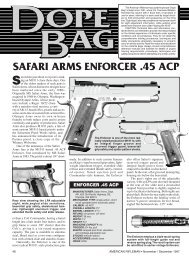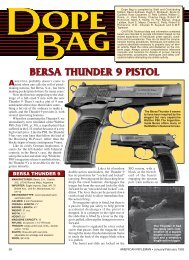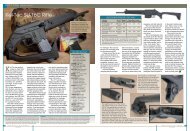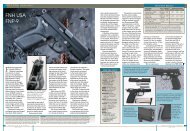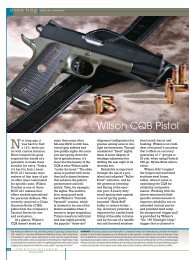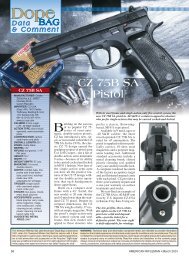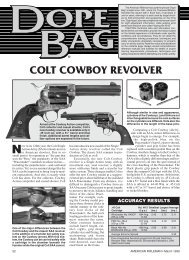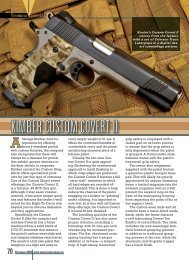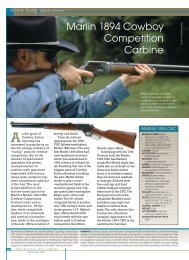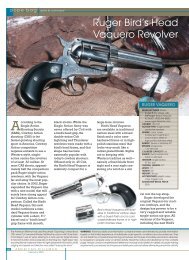practically
Download AR Dope Bag Oct. 2001
Download AR Dope Bag Oct. 2001
- No tags were found...
You also want an ePaper? Increase the reach of your titles
YUMPU automatically turns print PDFs into web optimized ePapers that Google loves.
profile—measuring 1.15" at the<br />
receiver ring and 0.700" just<br />
rearward of the muzzle brake.<br />
A 0.375"-thick recoil lug is<br />
sandwiched between the barrel<br />
shoulder and receiver face.<br />
Threaded to the barrel is the<br />
AR-30’s muzzle brake, scaled<br />
down from the one used on the<br />
AR-50. Two sets of rearwardangled<br />
baffles redirect propellant<br />
gases to reduce the gun’s<br />
perceived recoil. The brake is<br />
composed of a main body and a<br />
top cover that attaches with<br />
eight machine screws.<br />
Three separate 6061 aluminum<br />
components make up<br />
the AR-30’s stock: an extruded<br />
forestock, a forged M16-style<br />
pistol grip section and a cast<br />
buttstock attached by machine<br />
screws to the rear of the forestock.<br />
The buttstock incorporates<br />
a 1" thick soft rubber<br />
recoil pad and an integral<br />
cheekpiece grooved for clearance<br />
of the cocking piece during<br />
bolt removal.<br />
A V-block-shaped recess<br />
cradles the action in the forestock<br />
that is designed to spread<br />
slightly when the two action<br />
screws are tightened, providing<br />
better contact. The U-shaped<br />
fore-end leaves the barrel completely<br />
free floating and can be<br />
rested on sandbags or support a<br />
bipod using the mounted QD<br />
sling swivel stud.<br />
An interesting feature of the<br />
gun is its wedge bedding system.<br />
Just forward of the recoil<br />
lug recess in the forestock is a<br />
steel block attached by a<br />
machine screw. Both the<br />
block’s forward face and its<br />
seat in the stock are slightly<br />
angled such that when the<br />
block’s machine screw is tightened<br />
it is cammed rearward<br />
against the recoil lug, pushing<br />
the lug firmly against the stock.<br />
This positions the action consistently<br />
and eliminates the<br />
need to “shoot in” the gun to<br />
seat the recoil lug.<br />
SHOOTING RESULTS<br />
.338 Lapua Vel. @ 15' Energy Recoil Group Size In Inches<br />
Cartridge (f.p.s.) (ft.-lbs.) (ft.-lbs.) Smallest Largest Average<br />
Lapua B408 2835 Avg. 4,463 30.0 0.71 0.95 0.84<br />
250 gr. FMJBT 14 Sd<br />
Lapua B408 2850 Avg. 4,509 30.0 0.76 1.18 0.97<br />
250 gr. FMJBT 18 Sd<br />
Handload No.1 2795 Avg. 4,337 28.6 0.68 0.89 0.81<br />
Lapua 250 gr. FMJBT 31 Sd<br />
Handload No. 2 3238 Avg. 4,658 27.8 0.93 1.45 1.21<br />
Hornady 200 gr. SP 9 Sd<br />
Average Extreme Spread: 0.96<br />
Measured average velocity for 10 rounds from a 26" barrel. Range temperature:<br />
83° F. Humidity: 55%. Accuracy for five consecutive, five-shot groups at 100<br />
yards from a bipod. Abbreviations: FMJBT (full metal jacket boattail), Sd<br />
(standard deviation), SP (spire point).<br />
We shot the AR-30 for<br />
accuracy and reliability at 100<br />
yds. using a Harris bipod and<br />
a Leupold Vari-X III 6.5-20X<br />
50 mm scope. Two lots of<br />
Lapua factory 250-gr. loads<br />
were used, along with two<br />
handloads. The results are<br />
listed in the accompanying<br />
table. There were no malfunctions<br />
of any kind.<br />
We obtained better accuracy<br />
than we expected from a relatively<br />
lightweight gun firing a<br />
cartridge of this<br />
power. Handloads<br />
with the Lapua 250-<br />
gr. bullet using<br />
Hodgdon 870 powder<br />
in once-fired<br />
Lapua cases and<br />
Federal 215M primers<br />
grouped slightly<br />
better than the factory<br />
loads. The<br />
handload with the<br />
200-gr. Hornady<br />
soft-point bullet using Alliant<br />
RL22 in once-fired Lapua<br />
cases and Federal 215M<br />
primers yielded a 1.21" average<br />
and a sizzling 3,238 f.p.s.<br />
Accuracy was aided by the<br />
gun’s light trigger, which<br />
broke at a crisp 3 1 ⁄2 lbs. pull.<br />
We were very surprised at<br />
the AR-30’s light perceived<br />
recoil that seemed about equal<br />
to a .243 Win., resulting in part<br />
from the gun’s nearly 12-lb.<br />
weight, but mostly from its<br />
highly effective muzzle brake.<br />
Note that the brake directs a<br />
considerable amount of both<br />
escaping gases and sound to<br />
the sides.<br />
The AR-30 has many obvious<br />
applications in both the military<br />
and law enforcement arenas.<br />
In addition, it has various<br />
other uses, including 1,000-yd.<br />
benchrest competition and<br />
long-range hunting of large<br />
game animals such as elk.<br />
With the hefty power of a<br />
.458 Win. Mag., the flat trajectory<br />
of the .300 Win. Mag., the<br />
light recoil of a .243 Win. and<br />
accuracy rivaling that of many<br />
factory varmint rifles, the AR-30<br />
offers a combination of attributes<br />
rarely found in a single<br />
gun/cartridge combination. At a<br />
suggested list price of $1,180,<br />
the new ArmaLite bolt gun represents<br />
an unusual value in a<br />
rugged, accurate and powerful<br />
multi-purpose rifle.<br />
The AR-30 muzzle brake (l.) features two sets of<br />
rearward-facing baffles to trap and redirect propellant<br />
gases. The aluminum stock (below) acts<br />
as a V-block to cradle the barreled action. Two<br />
action screws pull the action down into the stock.<br />
The bedding wedge (below arrow) is cammed<br />
rearward as its screw is tightened, pushing the<br />
recoil lug tightly against its seat. The rifle has a<br />
pushbutton bolt release (above arrow), Shilen<br />
trigger and, sandwiched between the barrel and<br />
receiver, a .375"-thick recoil lug. The AR-30 bolt<br />
head (above l.) features two oversize lugs, a<br />
sliding-plate extractor and spring-loaded<br />
plunger ejector. The head is attached to the bolt<br />
body by a crosspin that allows the head to pivot<br />
slightly and seat both lugs in the receiver ring.<br />
AMERICAN RIFLEMAN • October 2001 75



